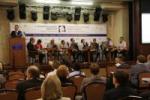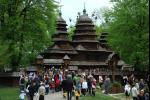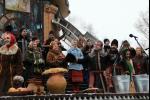Religion
Ukraine is a polytheist state with Christian traditions preferring. Today mostly Christian programs represent Ukrainian religious life, but there are some Judaism and Muslim representatives. Since the end of the 1980’s some neo- pagan communities have appeared in Ukraine. There has also been an increase in the number of other religious groups and philosophic trends (Buddhism), and especially non-traditional and new religious movements.
Over 97% of the religious communities now registered in Ukraine are Christian. About half of these communities are of the Orthodox tradition. The other half is divided among Catholics and Protestant traditional churches in Ukraine, according to nonofficial terminology there are: the Ukrainian Orthodox Church-Moscow Patriarchate (UOC-MP), Ukrainian Orthodox Church-Kyivan Patriarchate (UOC-KP), Ukrainian Autocephalous Orthodox Church (UAOC), Ukrainian Greek Catholic Church (UGCC), Roman Catholic Church (RCC), Armenian Catholic Church.
The Ukrainian Orthodox Church-Moscow Patriarchate
The Ukrainian Orthodox Church-Moscow Patriarchate is the former Ukrainian exarchate of the Russian Orthodox Church (ROC). In January 1990 it received its new name. Later that year it received "self-governance," though it is still canonically subjected to the Moscow Patriarchate. The local council of the UOC-MP requested to receive canonical autocephaly after Ukraine became independent in 1991. The request was not granted by the council of hierarchs of the ROC. As a result, the head of the UOC-MP, Metropolitan Filaret (Denysenko) was deprived of his status.
The great majority of bishops of the UOC-MP eventually repudiated their signatures in support of autocephaly. In May 1992 they elected, Volodymyr (Sabodan), Metropolitan of Rostov and Novocherkassiy, as new head of the Church. He is still its Head, with the title of Metropolitan of Kyiv and all Ukraine.
The Ukrainian Orthodox Church-Kyivan Patriarchate
The Ukrainian Orthodox Church-Kyivan Patriarchate was created in June 1992 by Metropolitan Filaret (who had been removed from the direction of the Ukrainian Orthodox Church-Moscow Patriarchate) and his supporters are from a part of the episcopate of the Ukrainian Autocephalous Orthodox Church. This was encouraged by some of the civil authorities, members of parliament and various nationalist political parties. Since October 1995 Filaret has been the head of this Church, with the title Patriarch of Kyiv and all Rus-Ukraine. The UOC-KP does not presently have official recognition from Orthodox Churches in other countries and so is considered "uncanonical."
The Ukrainian Autocephalous Orthodox Church
There were autocephalous movements in Ukrainian Orthodox in the 19th and early 20th centuries, but the Soviets under Stalin liquidated them. New communities of the Ukrainian Autocephalous Orthodox Church began to spring up in August 1989 in western Ukraine. Volodymyr Yarema, a Russian Orthodox pastor in Lviv, left the Russian Orthodox jurisdiction. He and a Russian Orthodox Bishop Ivan Bondarchuk joined the movement for autocephaly and then parishes began to join the Autocephalous Church.
The spread of autocephaly in Ukraine was part of a dispute with the Moscow Patriarchate., but it was also in the context of a fierce competition with the revival of the Ukrainian Greek Catholic Church. It was most certainly with the support of Orthodox Churches of the Ukrainian Diaspora in North America.
One of the hierarchs of these Diaspora Churches, Mstyslav (Skrypnyk), was proclaimed head of the UAOC, and in June 1990 at a council of this Church he was elected Patriarch of Kyiv and all Rus-Ukraine. Dymytriy (Yarema) was his successor from 1993 to 2000 and was then succeeded by Metropolitan Mefodiy (Kudryakov) of Ternopil, currently the head of the UAOC in Ukraine.
Although the UAOC does not currently have official recognition from Orthodox Churches in other countries, it has made steps towards achieving canonical status. For this reason, the name of Metropolitan Kostyantyn, head of the canonically recognized Ukrainian Orthodox Church in the USA (under the jurisdiction of the Patriarchate of Constantinople) is commemorated in the churches of the UAOC.
The Ukrainian Greek Catholic Church (UGCC)
Catholics of the Byzantine rite, known as Greek Catholics, are heirs of the Union of Brest of 1596, which the hierarchy of the Kyivan Metropolia established with the Church of Rome. The Kyivan Church was challenged by the Protestant Reformation and the renewed Catholicism of that period and was also suffering a serious internal crisis. The Synod decided to pass under the jurisdiction of the jurisdiction of Rome. The traditional Eastern rite of the Kyivan Church was preserved and its ethnic, cultural and ecclesial existence was guaranteed. This was confirmed at the Council of Brest in 1596, which is the beginning of the Ukrainian Greek Catholic Church as an institution.
All of Ukraine had been part of the Polish-Lithuanian Commonwealth at the time of the Council of Brest, and western Ukraine remained so. The Church played a leading role in preserving the cultural and religious independence of the Ukrainian population there. As the Western Ukrainian lands later passed into Austrian control, the imperial government of the Hapsburgs supported and protected the Greek Catholic hierarchy.
At the beginning of the 20th Century the Greek Catholic Church in Halychyna was graced by the exemplary leadership of Metropolitan Andrey Sheptytsky (1901-1944). He was the spiritual leader during two world wars and seven changes of political regime, including Nazi and Soviet. His tireless pastoral work, his defense of the rights of his people, his charitable and ecumenical efforts made the Church an influential social institution in Western Ukraine.
The war on religion was the ideology of the Communist regime and no effort was spared. Church buildings were ruined, burnt down, and profaned. The priests and faithful, Orthodox, Catholic and representatives of other religions were shot, arrested and deported to the Siberian gulag. The church communities were persecuted, confined to underground activities or entirely destroyed. Both the Ukrainian Autocephalous Orthodox Church at the beginning of the 1930s and the Ukrainian Greek Catholic Church in 1946 in Halychyna and in 1949 in Transcarpathia were liquidated. The Roman Catholic Church and Protestant churches survived in only a handful of carefully monitored churches.
With the crisis of Soviet power in the 1980s, the suppression of churches ceased. The formerly forbidden Ukrainian Greek Catholic Church emerged from the underground and communities of the Ukrainian Autocephalous Orthodox Church were created in 1989. The declaration of Ukrainian independence in 1991 created a new context for the activities of all the churches in this territory. Thus, official religious freedom in Ukraine opened the way for religious pluralism.
In spring 1991 Myroslav-Ivan Cardinal Luybachivskuj, the former church Head returned from emigration to Lviv. Containing 3,317 communities UGCC is considered to be the second largest church in Ukraine. His Beatitude Lubomyr Cardinal Husar is the Major Archbishop of UGCC.
The Roman Catholic Church (RCC)
Roman Catholic Church (RCC) is the second largest Catholic Church in Ukraine concerning the number of parishes; Catholics of the Latin rite are members of this Church. In 961, Quinn Olga invited German Latin Bishop to Kyiv and in 977 the first ambassadors came to Kyivan Rus'. During the period 977-979 the Latin church headed by Archbishop St. Bonifazuj was carrying out its activity in Kyiv. In 988 Prince Volodymyr the Great established Christianity, and as a result ambassadors from Rome paid visits to Kyivan Rus' and brought parts of relics of the Saints for newly created temples.
Kyiv Church kept in touch with Roman Catholic Church even after the split in 1054. In 1321 the first Latin bishop activity was set up at the territory of Ukraine. At the end of 16th century bishops-Jesuits created Jesuit collegiums, where Orthodox youth were educated as well. This resulted in the Latinization of Ukrainian society and mostly magnates and gentry. In addition to mentioned above orders there were Bernardyny, Carmelites, Capuchins, Augustins, Paulines, Trinitarians, numerous female orders. During Soviet times the Catholic Church in Ukraine was also destroyed. On January 16, 1991 the Pope Ivan Pavlo II renewed Roman Catholic communities and appointed bishops. In 1992 Apostle Nunciature was set up in Ukraine.
Armenian Catholic Church
The Armenian Catholic Church (ACC) is one of the Eastern Catholic Churches. It was created as a result of the union of part of the Armenian Apostolic Church with the Roman Apostolic See. Armenia (Gregorian) eparchy existed in Lviv in XIV ct. with the jurisdiction over Russ, Moldova and Valakhiya. In the first half of the 20th century there were approximately 5500 Armenian Catholics in Galicia (Halychyna). They had 9 churches and 16 chapels. The only one Armenian Catholic monastery was sisters- Benedict monastery in Lviv, which used to keep a private school that was well-known for its high level of education.
Just prior to World War II, Archbishop Yosyf Teodorovych died and there was no time to appoint a new archbishop. From 1939 to 1945 the Church weakened significantly. Due to military conflicts, first German and then Soviet, the number of clergy was cut in half. Following Ukrainian independence, the Armenian Catholic Church has been gradually reviving, with the first community registering in 1991 in Lviv.
In Autumn 2001, Nerses Bedros, patriarch of Cilicia and the head of the Armenian Catholic Church arrived in Ukraine intending to visit the centers of Armenian Christians that scattered all over Ukraine.
Lutheran Churches
Lutheranism is a traditional Protestant denomination in Ukraine that has been known since the mid-sixteenth century in Volhyn, Halychyna, Kyiv, Podillia and Pobuzhzha. Lutheranism in contemporary Ukraine is represented by three principal denominations: the Ukrainian Lutheran Church, the German Evangelical Lutheran Church and the Church of Sweden.
The Ukrainian Lutheran Church (The Ukrainian Evangelical Church of the Augsburg Confession) was established in 1926. It was active in western Ukraine until 1939. Under the Soviet regime, the ULC was persecuted by the church buildings and property being confiscated. Many of the faithful and pastors were repressed and some were forced to emigrate. Since the independence of Ukraine in 1991, ULC communities have started in Kyiv, Ternopil, Kremenets, Zaporizhzhia, Sevastopol, Simferopol and other centers.
During August 25-27, 2000, Bishop Vyacheslav Gorpynchuk was appointed as the Head of ULC episcopacy.
The German Evangelical Lutheran Church in Ukraine (GELS) dates back to the local Lutheran communities of German settlers of the mid-eighteenth century. In 1765, Pastor Christopher Lebrecht Graal arrived in Kyiv as a tutor for the family of a German pharmacist. He began holding religious services in this domestic “parish” and soon gathered many German Lutherans from all over Kyiv.
From 31st January through 2nd February in 1992, the First Constituent Synod of the GELC of Ukraine was held in Kyiv with participants from six Ukrainian cities (Dnipropetrovsk, Zaporizhzhia, Kyiv, Lviv, Odesa and Kharkiv), as well as delegations from Russia, Germany and Romania. Pastor Volodymyr Lisnyi of Feodosia was elected the new president. Pastor Edmund Ratz became bishop and Pastor Mykola Bendus from Lviv was made his deputy.
Baptists
The Baptist Church is one of the most widespread Protestant confessions in Ukraine. In 16th century Ukraine, there were Anabaptists, the predecessors of today’s Baptists. The first Baptist baptism in Ukraine took place in 1864 on the river Ingul in the Yelizavethrad region (now Kirovohrad region) in a German settlement. In 1867, the first Baptist communities were organized in that area. From there, the trend spread to southern Ukraine and then to other regions as well.
From the 1920s, Evangelical Christians and Baptists were illegal in Soviet Ukraine and the whole USSR. In the 1970s, another revival began. Today, Evangelical Christian Baptists are one of the most active Christian confessions in Ukraine and the world. Nearly 90% of Baptists in Ukraine are united in the All-Ukraine Union of the Association of Evangelical Baptists (AUU AEB), headed by the president of the council Hryhorii Komendant.
Pentecostals
Pentecostalism is a Protestant religious trend, which originated at the end of the 19th century. At the beginning of the 20th century, Pentecostalism came to the Russian Empire and from there to Ukraine.
On May 25-26, 1990, a convention was held in Korosten, where the All-Ukraine Union of Christians of the Evangelical Faith-Pentecostals was revived. It incorporated Pentecostal communities from the All-USSR Association of the ECB, independently registered and unregistered churches, and missions. Mykola Melnyk was elected head of the union. In 1998, he was replaced by Mykhailo Panochko.
Seventh-day Adventists
Adventism is one of the most numerous Protestant confessions in Ukraine. Adventism appeared in 30-40th of the 19th century in USA in society of Baptists, Methodists and other representatives. Adventism doctrine is based on expectation of the end of the world and Juice’s doomsday. A peculiar feature of this religion is that Adventists honor Saturday (that’s why they call themselves the Seventh-day Adventists). The Seventh-day Adventists appeared in Ukraine in 1847 in southwestern Ukraine’s Chernivtsi region, where M. Chekhovskyi was the first preacher. In 1931, the SDA organization was liquidated by the Soviet regime.
The SDA resumed its activities during Perestroika. The Ukrainian Union Conference (UUC) operates in Ukraine today. It consists of 8 regional conferences. The UUC-SDA has been headed by Volodymyr Krupskyi since 1998. Except the UUC-SDA, there are communities of Reformed Adventists, the Adventist Christian Church, and the Church of God (of the Seventh Day) operating in Ukraine.
The Armenian Apostolic Church
The Armenian Apostolic Church is one of the branches of the Oriental Orthodox Churches and its roots reach back to apostolic times. In the second half of the first century the apostles Sts. Thaddeus and Bartholomew preached Christianity in Armenia and established the first Christian communities there. These apostles were martyred here for the activities they were doing. Since these apostles, disciples of Jesus Christ, brought Christianity to the Armenian nation, the Armenian Church is called Apostolic. The name Gregorian Church originates in the name of St. Gregory the Confessor.
In 506 Armenian Church Synod didn’t accept Jesus’ teaching of the ecumenical council in Chalcedony in 451. That is why the ACC is considered to be one of the oldest Eastern Catholic Churches. Armenians were present in Ukraine long before the creation of the Kyivan state. The Armenian Church became an important bearer of national identity in the conditions of the Diaspora. In 1364 the Armenian Catholics, Mesrob the First, established an Armenian diocese in Lviv, and in three years the Polish King Casimir the Great confirmed this with his decree. In this way the Armenian Church of the Dormition of the Mother of God in Lviv (dedicated in 1363) became the cathedral parish and diocesan center of all the Armenians of Rus.
In 1630 bishop, Mykola Torosovych, proclaimed union with Rome at the Lviv Cathedral of the Carmelites. In 1635 he repeated it in the presence of Pope Urban VII (1623-1644) after receiving the title of archbishop.
On 28th of November in 1991 the diocese of the Armenian Apostolic Church was officially restored and registered in Ukraine, and now there are communities active in Lviv, Kyiv, Odessa, Kharkiv, Donetsk, Dnipropetrovsk and a few cities in Crimea. In 2001 Armenian Catholics Karekin named Bishop Gregory Buniatian head of the Ukrainian eparchy of the Armenian Apostolic Church.
The Sub-Carpathian Reformed Church (SCRC)
The fundamental principles of the faith and church order of the Reformed Churches are found in the works of Zwingli and Calvin written during the 1520s and 1530s. The majority of the faithful of the SCRC are ethnic Hungarians. First communities of reformers appeared in 1620s and 30s Today there are over 100 communities of the SCRC in 8 districts of the Sub-Carpathian region where there is a large Hungarian population. Thus territory is divided into three church districts (Uzhanskuj, Berezenskuj, Maromarosh-Ugochanskuj).
Judaism
Jews living at the territory of Ukraine have the historical legacy common with the east-European Jewish community, especially with the Jews of Russia, Belarus, Poland and Romania. In the beginning of the 20th century Jews created different forms of Jewish religion and national identity. This helped them to adjust themselves to the social and political situation existing in that region ‘til 1939. A lot of local Jews professed Chasidism that is a fanatic religious movement of the 18th century, and others were fond of the European Enlightenment.
At the end of 19th century and the beginning of the 20th century more and more Jews of East Europe joined new political parties. The majority of East Europe Jews spoke Yiddish. A lot of outstanding writers spoke Yiddish at the territory of modern Ukraine, especially ones living Odesa, Kyiv, Lviv and Chernivzi. They are Mendel Moshem Sphorim and Sholom Alejkhem, who have been living in Odesa for a long time. In their works they depict changeable social, political and economic realities of East Europe community.
Islam
Historically, Crimea was the center of the spread of Islam in Ukraine. In the middle of the 15th century the Crimean Tatar Khanate was established there. It soon was reduced to a vassal state of the Ottoman Empire.
The Spiritual Direction of the Muslims of Crimea (SDMC) was established in 1991 and comprises approximately 70% of all government-registered Muslim communities in Ukraine. It is considered the spiritual center of the Crimean Tatars. The SDMC runs its own spiritual school, publishes its own literature and a newspaper that is called “Hidiaet” in the Tatar language. The direction is headed by Mufti Kirim Esende.
The Spiritual Direction of the Muslims of Ukraine (SDMU) was established in 1992 in Kyiv and in 1994 the first congress was held, at which a presidium of the direction was set up and Tamin Achmed Mohammed Mutach was elected Mufti. The direction seeks to unite Muslims of different nationalities, regardless of their cultural differences. The SDMU has representative offices in 10 regions and has the second-largest number of Muslim communities in Ukraine. It runs the Islamic Institute in Kyiv and publishes a Russian-language newspaper that is called “Minaret.”
The Spiritual Center of the Muslim Communities of Ukraine was established on the basis of the Independent Spiritual Direction of the Muslims of Ukraine that was registered in 1994. The center is comprised of Muslim communities that are predominantly of the Tatar nationality in 12 regions. It is known as a national-religious organization. Its directing body is based in Donetsk, where there is also an Islamic cultural center. Rashid Brahin was elected head of the presidium. In 1997 the center founded the Party of Muslims of Ukraine.
Buddhists
Buddhists try to avoid negative emotions, which bring sufferings while positive emotions bring happiness karma (“causality”). The main practice of Buddhism is meditation or “to be in without any efforts”.
Ukrainian Association of Karma Kaguy (one of the three trends of Buddhism) was set up in 1996 in order to spread this religion. Today it is the biggest Buddhism net containing 16 centers. Their headquarters are located in Uzhgorod. The first west Lama, founder of 300 Karma Kaguy centers, and now Lama Ole Nidal runs the Association. Other trends and derivative movements of Buddhism are active in Ukraine.
Pagan Religion
In 1934 Pr. Volodymyr Shajan set up nonpagan movement – “Ridna Vira” (Native Faith). Lev Sylenko created it after the Word War II in Ukrainian Diaspora another nonpagan cult - Native Ukrainian National Faith. The basic principles of Native Ukrainian National Faith are depicted in L. Lysenko’s work “Maga-Vira”(Magic-Faith).









